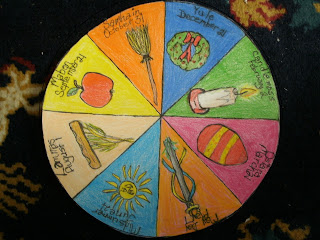Samhain, also known as Halloween, occurs from sundown October 31st to sundown November 1st. it is a time when inhabitants of either side of the hedge can slip over to the opposite side. This also creates an interesting opportunity for those wishing to communicate with the dead to do so. As well it makes for easier traveling if you are seeking knowledge in the other realm. Often a place is set for ancestors to join in on the feasting on this night.
It is common belief that “trick or treating” was created in the United States, however, guising was a popular occurrence on Samhain as early as 1895, with poor young children adopting a disguise, or “guise” by wearing a mask with a costume. The children would then sing a song or perform a prayer for the dead in exchange for cakes or coin.
The end of October, marks the end of the harvest and over the next few days the start of the darker half of the year. This harkens back to ancient times when the year was divided into two parts, Summer and Winter. Since the weather has become too cold for anything to continue growing, it is now an auspicious time to take stock of the herds and grain supplies, deciding which animals need to be slaughtered in order for the people and livestock to survive the winter. It is still practiced today by those who farm and raise livestock, because it is when meat will keep since the freeze has come and also since summer grass is gone and foraging is no longer available.
The bonfire also played an important part of many Samhain rituals. In the pre-Christian Gaelic world, cattle was a primary unit of currency and center of agricultural and pastoral life. This time of year became the perfect time for villagers to take stock of what they had, what they needed and prepare the goods so they would last the coming winter. The bonfire was used as a ritual cleansing tool, the villagers forced the cattle between two bonfires and tossed the bones from the slaughter into the fire. Once the bonfire was ablaze, villagers put out all other fires. Each family solemnly lit its hearth from the common flame, bonding the families of the village together. Two bonfires were built side by side and people would walk between the flames for ritual purification, sometimes including cattle and livestock.
Iconic images: cauldron, jack-o-lantern, mask, besom, balefire.
Yule December 21
Imbolc February 1Ostara March 21
Beltane May 1
Summer Solstice June 21
Lammas August 1st
Mabon September 21
